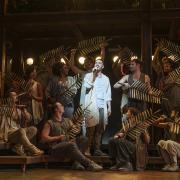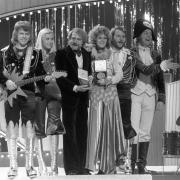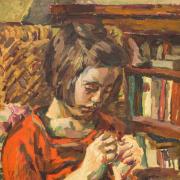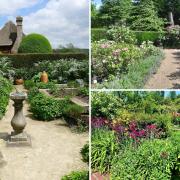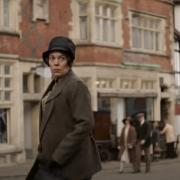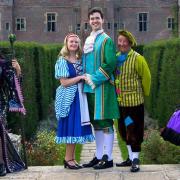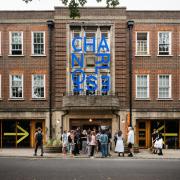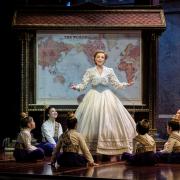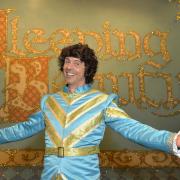At some point in their lives, nearly half the women in the UK have been involved in Girl Guiding. As Guiding celebrates its centenary this year, we look at the development of East Grinstead's dedicated girls
Meeting times had to be altered to take place in daylight, and a War Service badge was instituted, being awarded for 96 hours of service in a year. Hartfield Guides helped the ARP week and were drilled by the Home Guard, Forest Row Guides ‘dug for victory’ and grew potatoes around their hut (although naturally they were uprooted by the boys), but Guides in East Grinstead fared better, sending their vegetables to the local hospital.
Proving the might of the movement, when money was collected in Guide Gift Week, a national total of �48,000 was raised and used to provide two air ambulances, 20 Naval ambulances, restrooms for the army, mobile canteens and a motor lifeboat.
Following the war, the 1950s were a decade of celebration with local Guide, Ann Peters, travelling to London to take part in the Coronation celebrations. 1957 saw the centenary of Baden-Powell’s birth, and Joan Swane was selected to attend the World Jamboree at Windsor Great Park, held in his honour. In East Grinstead, Guides joined with Scouts to present a pageant entitled ‘From Acorn to Oak’, and by 1958 the local Guides had grown to such an extent it was decided to split the organisation into two districts.
By the 1970s, an increase in cooperation between local Guides and Scouts saw joint camps held in the Brecon Beacons, allowing the opportunity to experience caving, climbing and hiking, as well as improving their camping skills. In 1970 Lady Baden-Powell visited Blackland Farm to attend a Diamond Jubilee camp, and five girls from East Grinstead took part in Diamond Dust, a cavalcade of Guiding at Eastbourne.
Celebrating the 75th anniversary of Guiding in 1985, many local Guides attended a pageant at Crystal Palace, which was memorable for all who attended thanks to its appalling weather. Snow and howling winds whipped the gathered masses, but with true grit the Guides carried on; a blanket badge was later issued reading ‘I survived Crystal Palace’.
And so to this year – the centenary. Two huge parties kicked off a year of celebrations and as a community project, the East Grinstead Division will be establishing a permanent nature trail around East Court Park. Available to all ages and families in the community, the aim of the trail is to encourage fitness, a wider use of the park and woods, and in interest in the local environment and surroundings.
That Guiding is celebrating its centenary is a huge triumph. It might have begun in another era but while the world around us has altered, the core values of Guiding haven’t and it continues to provide a safe, girl-only space to explore the activities, issues and possibilities available to girls today, and to give them a voice.
With two seats within the United Nations and more than ten million members in 145 countries, whether they’re abseiling off a cliff, tussling with a tent, canoeing, getting involved with the community or brushing up on cookery, there can be no better place to learn life skills for the modern world. Here’s to the next 100 years.
Join in
The East Grinstead Centenary Trail will be launched on 6 June at 2pm at Eastcourt Manor, so head down for an afternoon of crafts, entertainment and fun for all the family.
Girlguiding UK has 65,000 trained adult volunteers; ordinary women and men who give their time to help girls achieve their goals through Guiding. For more information on becoming a volunteer or getting involved, contact Linda Hare, tel: 01342 318177
Be prepared
At some point in their lives, nearly half the women in the UK have been involved in Girl Guiding. As Guiding celebrates its centenary this year, we look at the development of East Grinstead’s dedicated girls
A quick wander around the excellent East Grinstead Museum will leave you in no doubt that the local Guides are quite a force to be reckoned with. A spectacular display, charting the history of the local Guides, the uniforms they wore, activities they took part in and people they helped, proves that this corner of Sussex has wholly embraced the movement, begun by Lord Baden-Powell 100 years ago.
Although records only go back to 1917, it’s known that there were Guides in East Grinstead as early as 1914, when a news item appeared in the East Grinstead Observer. The story covered 24 girls from the town who attended a rally at Crowborough, where they took part in displays and were inspected by Miss Agnes Baden-Powell, president of the Guides and sister to Robert Baden Powell.
By 1917, companies had been formed at St Mary’s Church and in Ashurst Wood, where there were two patrols; the Buttercups and the White Roses. Classes for drilling, signalling and first aid were held; exciting pastimes for girls in this period, and shows that guiding has always attracted girls who enjoy challenging themselves with new activities.
In the same year, a group of enthusiastic local ladies formed a Local Association to promote Guiding in the area, and a year later further impetus was given to the movement when Lady Baden-Powell addressed a meeting held in Queen’s Hall, to which the Heads of local girls’ schools, clergy and ministers were invited. Shortly after, Mrs Blount, of Imberhorne Manor, was appointed Divisional Commissioner and she remained involved with Guiding for some years.
During the early days, badge work was taken very seriously; examiners were appointed by the Local Association, and examinations were held twice yearly.
Among others, Guides at the time were able to take Poultry Keeper and Land Worker badges, as well as Milliner and Sick Nurse but for the more adventurous, Electrician and Telegraphist badges were also on offer.
By the time Miss Helen Beale of Standen became District Commissioner in 1920, there were seven companies in East Grinstead at Forest Row, Coleman’s Hatch, Hartfield, West Hoathly and Turners Hill, two at Crawley and a Brownie pack at Crawley Down. Feeling it was time to have their own HQ, in 1928 the Guides rented the Civic Arts Hall.
By the late 1930s, with camping being a high priority for the Guides, Alfred Wagg leased Blacklands Farm to the groups and it has been a popular campsite ever since, developing into a major activity centre and attracting visitors from all around the world. During the war camping was allowed only in camouflaged tents, and the conflict was to bring about many changes to Guiding.



